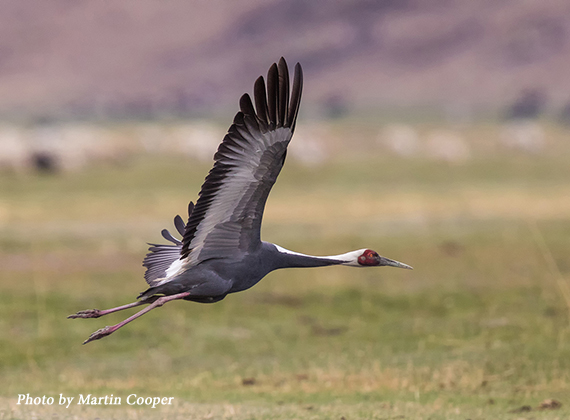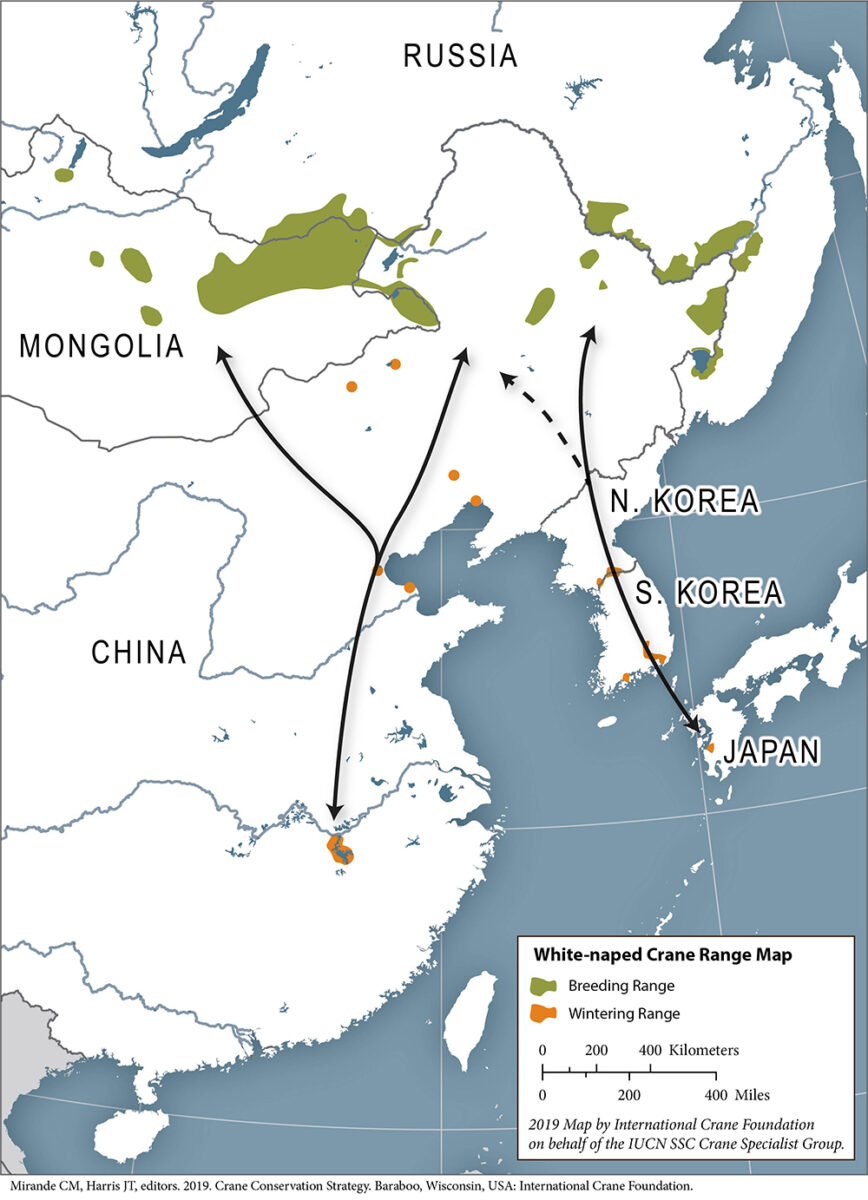
SPECIES: Grus vipio
HEIGHT: ~ 130 cm, 4 ft
WEIGHT: ~ 5.6 kg, 12 lbs
POPULATION: 6,700 – 7,700
TREND: Eastern population increasing; western population decreasing
STATUS:IUCN: VU; ESA: E; Cites Appendix I; CMS I, II
IDENTIFICATION
Adults – dark grey and white striped neck, reddish face patch, body plumage is dark grey, wings are silvery grey, pinkish legs; juveniles – body plumage mix of grey and cinnamon-brown, striping on the neck not as distinct as the adults.
RANGE
White-naped Cranes breed in northeastern Mongolia, northeastern China and adjacent areas of southeastern Russia. Birds in the western portion of the breeding range migrate south through China, rest in areas on the Yellow River delta and winter at wetlands in the middle Yangtze River valley. Approximately 2,000 birds in the eastern portion of the breeding range migrate south through the Korean peninsula. Several hundred remain on wintering grounds in the Demilitarized Zone (DMZ) between North and South Korea. The remainder continues on to the Japanese island of Kyushu, where they heavily rely upon an artificial feeding station located outside the city of Izumi.

DIET
Insects, small vertebrates, seeds, roots and tubers, wetland plants, and waste grains. At the artificial feeding station at Izumi in Japan, White-naped Cranes thrive upon rice and other cereal grains.
CALL
Listen to White-naped Crane calls:
![]() Guard Call | A sharp, single call expressing alarm.
Guard Call | A sharp, single call expressing alarm.
![]() Unison Call | A duet performed by a pair, to strengthen their bond and protect their territory.
Unison Call | A duet performed by a pair, to strengthen their bond and protect their territory.
THREATS
Habitat loss, especially due to changing hydrology, such as water diversions and the unsustainable conversion and exploitation of wetlands, illegal take including hunting, trapping and poisoning, human disturbance, fire, conversion of grasslands, power line collisions, pollution and environmental contamination, changes in agricultural practices, and disease outbreak at the Izumi Feeding Station in Japan.
OUR PLAN
Our work builds on the strong cultural ties to cranes in East Asia, to engage local communities and policy makers in the conservation of protected areas and their surrounding landscapes, including:
Ensure healthy populations of White-naped Crane populations in the Amur-Heilong Basin of Russia and China. We are:
- Supporting the development and implementation of water management plans that sustain crane habitats and preserve wetlands for wildlife, flood control, enhancement of water quality, fisheries and other harvests important to people at Zhalong, Momoge, Xianghai, Tumuji, Muraviovka and other key crane wetlands.
- Developing pilot projects in China and Russia that demonstrate community involvement with wetland conservation.
- Promoting cooperative research efforts between crane conservationists in Mongolia and the Amur-Heilong basin of Russia and China.
- Conducting environmental education activities among communities and stakeholders affecting critical crane habitat to increase local and national pride and commitment to conservation action.
Supporting increasing winter populations of White-naped Cranes and maintaining the extraordinary diversity of other waterbird species in Poyang and nearby lakes in southeastern China. We are:
- Determining the effects of different water management scenarios on cranes and their aquatic plant food base.
- Promoting ecosystem approaches to management, including strategies to manage degradation caused by water infrastructure and economic development within its basin.
- Collaborating with Chinese agencies, researchers and local communities to demonstrate how fisheries management and crane protection go together.
- Supporting efforts by management agencies and partners to identify and restore alternative wintering sites for cranes in southern China.
Securing wintering grounds for White-naped Cranes in and near the Demilitarized Zone of the Korean Peninsula. We are:
- Facilitating technical exchange, dialogue and collaboration with North and South Korean scientists and decision-makers.
- Restoring crane wintering areas in the Anbyon Plain of North Korea by assisting the local farming community in developing sustainable farming methods while providing food for cranes.
- Developing habitat management plans for the conservation of coastal wetlands in southwest North Korea.
- Supporting efforts within South Korea to protect Choelwon and other current wintering sites.
Learn more about White-naped Cranes:
